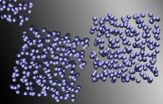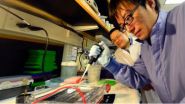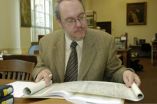(Press-News.org) The Atlantic razor clam uses very little energy to burrow into undersea soil at high speed. Now a detailed insight into how the animal digs has led to the development of a robotic clam that can perform the same trick.
The device, known as "RoboClam," could be used to dig itself into the ground to bury anchors or destroy underwater mines, according to its developer, Amos Winter, the Robert N. Noyce Career Development Assistant Professor of Mechanical Engineering at MIT.
Despite its rigid shell, the Atlantic razor clam (Ensis directus) can move through soil at a speed of 1 centimeter per second. What's more, the animal is able to dig up to 0.5 kilometers using only the amount of energy contained in a AA battery. "The clam's trick is to move its shells in such a way as to liquefy the soil around its body, reducing the drag acting upon it," Winter says. "This means it requires much less force to pull its shell into the soil than it would when moving through static soil."
To develop a robot that can perform the same trick, Winter and his co-developer, Anette Hosoi, professor of mechanical engineering and applied mathematics at MIT, needed to understand how the clam's movement causes the soil to liquefy, or turn into quicksand, around its shell. Now, in a paper to be published in the journal Bioinspiration and Biomimetics, the researchers reveal for the first time the mechanics behind this process, and describe how their robot is able to mimic this action.
Mechanics of quicksand
When the razor clam begins to dig, it first retracts its shell, releasing the stress between its body and the soil around it. This causes the soil to begin collapsing, creating a localized landslide around the animal. As the clam continues to contract, reducing its own volume, it sucks water into this region of failing soil. The water and sand particles mix, creating a fluidized substrate — quicksand.
But the timing is crucial. If the clam were to move its shell too slowly, the sand particles would collapse around the animal without fluidizing, Winter says. However, if the clam moved too quickly, it would not give the sand particles enough time to mix with the water flowing past, and they would simply remain stationary. "Our data showed that there was a very abrupt transition from being able to fluidize the soil to not moving the soil particles at all," he says.
To develop a low-energy anchoring system that can create quicksand around itself in this way, the researchers built a mechanical puppet clamshell, consisting of two halves that can move together and apart in a similar way to an accordion. The puppet clam is connected to a rod, which can open and close the shell and push it up and down, creating the same contractions as the animal can achieve.
To make it easier to test their RoboClam prototype in salt water, the researchers used a compressed air system to power the expansion and contraction of the shells. Winter's team is now developing an electronic version, which will make it compatible for use with underwater vehicles developed by the team's sponsor, Bluefin Robotics, an MIT spinout based in Quincy, Mass.
Energy-saving anchoring
Winter first began developing the RoboClam for his PhD research in 2006, alongside Hosoi. The researchers wanted to find a way to anchor autonomous underwater vehicles to a seabed or riverbed without consuming a great deal of energy. Robotic vehicles have limited battery power, so any energy consumed by the anchoring system would reduce the device's operating time.
"You might be operating these vehicles in a current, and need them to be stationary — for example, to monitor a biological situation, or for military purposes," Winter says. "You wouldn't want the vehicle constantly spinning its propellers in order to stay in one place because that just wastes energy, so it would be nice if you could just deploy an anchor and maintain your position without expending any energy."
In addition to anchoring underwater vehicles and detonating mines, the RoboClam could also be used to lay underwater cables, Winter says. Companies that lay trans-Atlantic cables traditionally use a ship to drag a sled along the bottom of the ocean to dig a trough, lay the cable, and cover it over. However, when the depth of the ocean water drops to 10 meters or less, it becomes too shallow for the ships to move through. This means human divers have to take over laying and burying the cables, which is both time-consuming and expensive. "Having a system that could just latch onto the cable, work its way along, and automatically dig it into the soil would be great," Winter says.
INFORMATION:
Written by Helen Knight, MIT News correspondent
'RoboClam' replicates a clam's ability to burrow while using little energy
Robot builds on insights into Atlantic razor clam dynamics.
2014-03-24
ELSE PRESS RELEASES FROM THIS DATE:
A new concept for manufacturing wrinkling patterns on hard-nano-film/soft-matter-substrate
2014-03-24
Wrinkling is a common phenomenon for thin stiff film adhered on soft substrate. Various wrinkling phenomenon has been reported previously. Wu Dan, Yin Yajun, Xie Huimin,et al from Tsinghua University proposed a new method to control wrinkling and buckling of thin stiff film on soft substrate. It is found that the curve pattern on the soft substrate has obvious influence on the wrinkling distribution of the thin film/soft substrate. Their work, entitled "Controlling the surface buckling wrinkles by patterning the material system of hard-nano-film/soft-matter-substrate", ...
Psychiatric complications in women with PCOS often linked to menstrual irr
2014-03-24
(NEW YORK, NY, March 24, 2014) – Polycystic ovary syndrome (PCOS), a hormone imbalance that causes infertility, obesity, and excessive facial hair in women, can also lead to severe mental health issues including anxiety, depression, and eating disorders. A study supervised by Columbia University School of Nursing professor Nancy Reame, MSN, PhD, FAAN, and published in the Journal of Behavioral Health Services & Research, identifies the PCOS complications that may be most responsible for psychiatric problems. While weight gain and unwanted body hair can be distressing, irregular ...
Statins could ease coughing in lung disease patients, study finds
2014-03-24
Common cholesterol-lowering drugs could provide relief to patients suffering from a chronic lung disease, a study has shown.
The drugs – known as statins – were found to help alleviate the chronic coughing associated with the disease for some patients.
Statins are commonly prescribed for people at risk of heart attack because they can reduce cholesterol levels, but scientists are increasingly finding that they also have anti-inflammatory effects.
Researchers at the University of Edinburgh have shown the therapeutic potential of statins to treat patients with an inflammatory ...
Gene implicated in progression and relapse of deadly breast cancer finding points to potential Achilles' heel in triple negative breast cancer
2014-03-24
NEW YORK – (March 24, 2014) – Scientists from Weill Cornell Medical College and Houston Methodist have found that a gene previously unassociated with breast cancer plays a pivotal role in the growth and progression of the triple negative form of the disease, a particularly deadly strain that often has few treatment options. Their research, published in this week's Nature, suggests that targeting the gene may be a new approach to treating the disease.
About 42,000 new cases of triple negative breast cancer (TNBC) are diagnosed in the United States each year, about 20 ...
Like being inside a star
2014-03-24
Some experiments are really difficult to perform in practice. To gain a detailed understanding of the behaviour of molecular hydrogen (H2), for example, we would have to produce such high pressures as those occurring within the core of gaseous planets like Jupiter and Saturn or inside stars. If such conditions cannot be created, an alternative method is to simulate them on the computer, but the model has to be accurate. A group of research scientists from the International School for Advanced Studies (SISSA) in Trieste used a simulation model that is far more accurate than ...
Pioneering research offers new insight into improved wave energy testing
2014-03-24
Pioneering research could provide a significant boost in the vital quest to harness wave power as a viable renewable energy source for the future.
Scientists from the University of Exeter have studied how wave energy developers can more accurately measure, and predict the wave conditions within wave energy test sites.
The research, which is published in leading scientific journal Energy, deployed wave measurement buoys and used wave modelling to show how variations in wave size and strength could be resolved.
The results should aid developers to better predict sea ...
Maturitas publishes position statement on management of vertebral osteoporotic fracture
2014-03-24
Amsterdam, March 24, 2014 – Elsevier, a world-leading provider of scientific, technical and medical information products and services, today announced the publication of a position statement by the European Menopause and Andropause Society (EMAS) in the journal Maturitas on the topic of the management of postmenopausal women with vertebral osteoporotic fracture.
Vertebral osteoporotic fracture is an underestimated condition as only about a third of people with the disease seek medical attention. While it may cause acute back pain, the presentation may be insidious with ...
Protein called YAP gives blood vessels strength, shape
2014-03-24
AUGUSTA, Ga. - A protein known to promote cancer appears to give the blood vessels strength and shape, researchers report.
When yes-associated protein, or YAP, is deleted from vascular smooth muscle cells during development, the protein makes thin-walled blood vessels that over-dilate in response to the usual pressure of blood flow, said Dr. Jiliang Zhou, vascular biologist at the Medical College of Georgia at Georgia Regents University.
"The thickness of the arterial wall decreases from three or four layers of smooth muscle cells to one or two layers," said Zhou, corresponding ...
From mouse ears to man's?
2014-03-24
One in a thousand children in the United States is deaf, and one in three adults will experience significant hearing loss after the age of 65. Whether the result of genetic or environmental factors, hearing loss costs billions of dollars in healthcare expenses every year, making the search for a cure critical.
Now a team of researchers led by Karen B. Avraham of the Department of Human Molecular Genetics and Biochemistry at Tel Aviv University's Sackler Faculty of Medicine and Yehoash Raphael of the Department of Otolaryngology–Head and Neck Surgery at University of ...
Guarding grapes and other tales from papyri
2014-03-24
If you weren't careful, you might end up beaten by grape thieves skulking in the darkness.
A University of Cincinnati graduate student writes about the contractual obligations of vineyard guards and researchers from around the world contribute more stories from ancient times in the most recent volumes of the Bulletin of the American Society of Papyrologists (BASP).
UC's Peter van Minnen, associate professor of classics, has edited the international journal since 2006. BASP is an annual collection of articles and reviews pertaining to important discoveries from around ...
LAST 30 PRESS RELEASES:
University of Oklahoma researcher awarded funding to pursue AI-powered material design
Exploring how the visual system recovers following injury
Support for parents with infants at pediatric check-ups leads to better reading and math skills in elementary school
Kids’ behavioral health is a growing share of family health costs
Day & night: Cancer disrupts the brain’s natural rhythm
COVID-19 vaccination significantly reduces risk to pregnant women and baby
The role of vaccination in maternal and perinatal outcomes associated with COVID-19 in pregnancy
Mayo Clinic smartwatch system helps parents shorten and defuse children's severe tantrums early
Behavioral health spending spikes to 40% of all children’s health expenditures, nearly doubling in a decade
Digital cognitive behavioral treatment for generalized anxiety disorder
Expenditures for pediatric behavioral health care over time and estimated family financial burden
Air conditioning in nursing homes and mortality during extreme heat
The Alps to lose a record number of glaciers in the next decade
What makes a good proton conductor?
New science reporting guide published for journalists in Bulgaria
New international study reveals major survival gaps among children with cancer
New science reporting guide published for journalists in Turkey
Scientists develop a smarter mRNA therapy that knows which cells to target
Neuroanatomy-informed brain–machine hybrid intelligence for robust acoustic target detection
Eight SwRI hydrogen projects funded by ENERGYWERX
The Lundquist Institute and its start-up company Vitalex Biosciences Announces Strategic Advancement of Second-Generation fungal Vaccine VXV-01 through Phase 1 Trials under $40 Million Competitive Con
Fine particles in pollution are associated with early signs of autoimmune disease
Review article | Towards a Global Ground-Based Earth Observatory (GGBEO): Leveraging existing systems and networks
Penn and UMich create world’s smallest programmable, autonomous robots
Cleveland researchers launch first major study to address ‘hidden performance killer’ in athletes
To connect across politics, try saying what you oppose
Modulating key interaction prevents virus from entering cells
Project explores barriers to NHS career progression facing international medical graduates
Jeonbuk National University researchers explore the impact of different seasonings on the flavor perception of Doenjang soup
Two Keck Medicine of USC Hospitals named Leapfrog Top Teaching Hospitals
[Press-News.org] 'RoboClam' replicates a clam's ability to burrow while using little energyRobot builds on insights into Atlantic razor clam dynamics.



